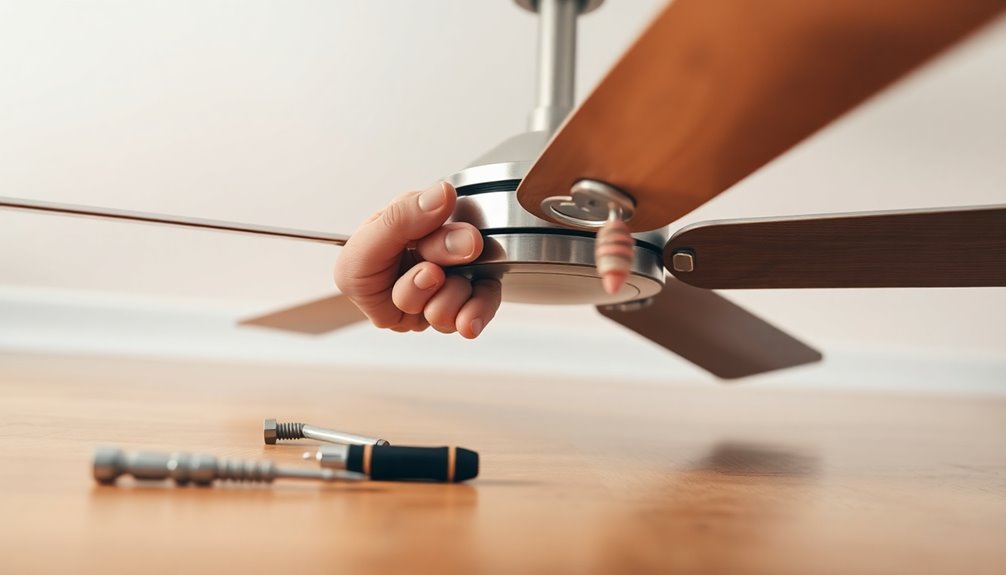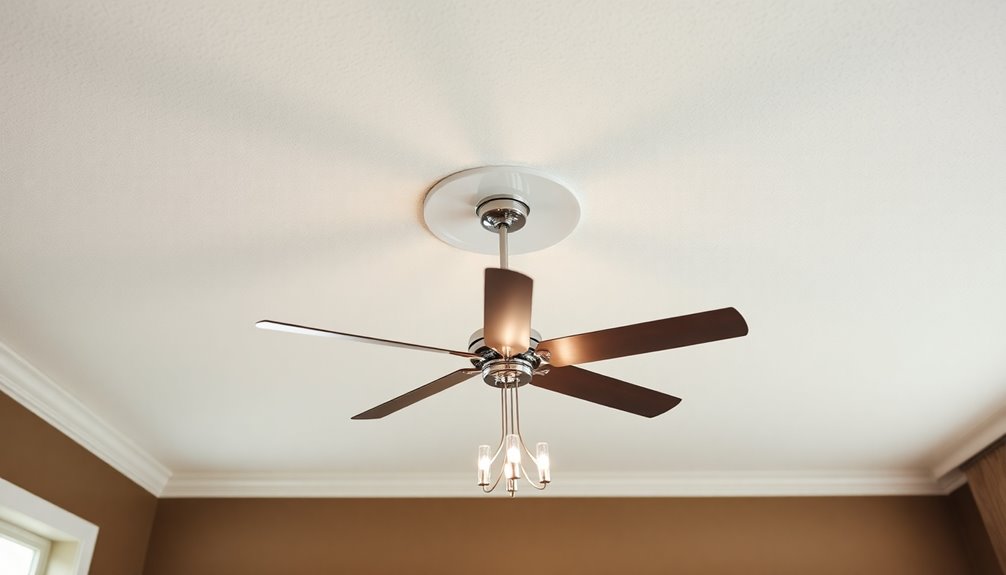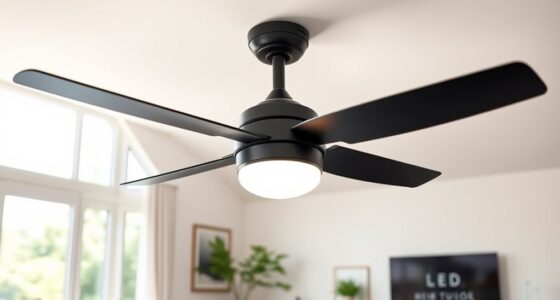To measure ceiling fan blades, focus on the blade span, which is the distance from one tip of a blade to the opposite tip. Start by turning off the fan for safety, then measure the distance directly across the circle formed by the blades. If your fan has an odd number of blades, measure from one blade tip to the center and double that measurement. This span helps you determine the right fan size for your room. Want to know how to choose the ideal fan size and guarantee proper installation? There's more to explore!
Key Takeaways
- Blade span is the diameter of the circle formed by the rotating blades of a ceiling fan.
- For even blades, measure from tip to tip; for odd blades, measure from a tip to the center and double it.
- Recommended blade spans are 29-36 inches for rooms up to 75 sq ft and 50 inches or larger for over 100 sq ft.
- Ensure at least 30 inches of clearance between blades and walls for optimal airflow and circulation.
- Measure the height from the ceiling to the desired blade height when calculating downrod length for installation.
Measuring Room Dimensions

When it comes to measuring room dimensions, you'll want to kick off by grabbing a tape measure. Start by measuring the length of the room from one wall to the opposite wall.
Next, measure the width using a perpendicular wall. With these two measurements, calculate the square footage by multiplying the length by the width. For example, if your room measures 10 feet by 12 feet, you'll find it equals 120 square feet.
If you have an L-shaped room, divide it into two rectangles, measure each separately, and sum their square footage for the total area.
Accurate measurement of room dimensions is essential for selecting the right ceiling fan size, ensuring effective cooling and airflow.
Don't forget to check the ceiling height as well. This measurement helps determine the appropriate downrod length for your ceiling fan, which is vital for ideal air circulation.
Understanding Blade Span

After you've measured your room dimensions, the next step is to understand blade span, which plays a significant role in how effectively a ceiling fan circulates air.
Blade span, or sweep, is the diameter of the circle formed by the rotating blades. To measure blade span accurately, turn off the ceiling fan first. If your fan has an even number of blades, simply measure from the tip of one blade to the tip of the opposite blade. For fans with an odd number of blades, measure from the tip of one blade to the center of the fan and double that measurement.
Choosing the proper blade span is essential for your room size. For example, fans with a span of 29-36 inches work well in rooms up to 75 square feet, while those with a span of 50 inches or larger are ideal for spaces over 100 square feet.
Additionally, guarantee at least 30 inches of clearance from the blades to any wall or obstruction to optimize air circulation and fan performance. Understanding these measurements will help you select the right ceiling fan for your needs.
Calculating Downrod Length

Getting the right downrod length is vital for optimal ceiling fan performance and safety. To calculate the appropriate downrod, first measure the distance from the ceiling to your desired height for the fan blades, which should ideally be 8 to 9 feet above the floor.
Next, subtract the height of the fan housing, typically ranging from 8 to 12 inches. For instance, if your ceiling height is 10 feet and you want the fan blades at 8 feet, you'll need a 12-inch downrod for ideal hanging height.
Remember, maintaining at least 8 inches of clearance between the fan blades and the ceiling is essential for proper airflow and preventing overheating.
Don't forget to take into account any additional height from light kits attached to your ceiling fan, as this can affect your downrod length calculations.
Finally, always account for potential obstructions like cabinets or light fixtures when determining the final downrod length. Ensuring a safe and effective installation means taking all these factors into account for the best results.
Selecting Appropriate Fan Size

Selecting the right ceiling fan size is vital for maximizing comfort and energy efficiency in your space. To determine the ideal fan size, start by measuring your room's square footage—multiply the length by the width. This calculation will guide you in selecting the appropriate blade span for effective air circulation.
Here are three key considerations when choosing your ceiling fan size:
- Room Size: For rooms up to 75 sq ft, opt for a fan with a blade span of 29-36 inches.
- Recommended Sizes: For spaces 76-144 sq ft, look for 36-44 inches, and for larger rooms (226-400 sq ft), go for a fan size of 50-60 inches.
- Clearance: Make certain there's a minimum of 30 inches clearance from walls to maximize airflow efficiency.
For larger rooms exceeding 400 sq ft, you might need multiple fans or oversized models (65 inches or more) for adequate airflow. Additionally, it's important to consider the average price range of ceiling fans, which can vary widely based on size and features.
Installation Considerations

Proper installation is essential for the safe and efficient operation of your ceiling fan. First, measure the ceiling height to determine if you need a downrod, guaranteeing the blades maintain at least 7 feet above the floor and 8 inches from the ceiling for ideal airflow. This helps achieve proper blade clearance, which is important for air circulation.
During installation, use a level to check fan alignment. Improper alignment can negatively impact airflow and create unwanted noise.
Also, consider the proximity of the fan to walls and large furniture; maintain a minimum clearance of 30 inches to avoid obstructions and guarantee effective air circulation.
Before you finalize the installation, verify the electrical compatibility of your ceiling fan with the existing wiring. This step is essential for safe and efficient operation post-installation.
By taking these considerations into account, you'll make sure your ceiling fan operates smoothly, enhancing comfort and aesthetics in your space.
Frequently Asked Questions
How Is a 52 Inch Ceiling Fan Measured?
To measure a 52-inch ceiling fan, you start from the tip of one blade to the tip of the opposite blade. This gives you the full blade span.
If your fan has an even number of blades, it's straightforward; just measure across. For an odd number of blades, measure from the tip of a blade to the center and double that.
This measurement helps guarantee you've got the right fan size for your room.
Is a 52 Inch Fan Too Big for a 12X12 Room?
Imagine a cozy living room with a grand chandelier—too big, it dominates the space.
But a 52-inch ceiling fan in a 12×12 room isn't overwhelming; it's just right. With a blade span that fits perfectly within the recommended 44-54 inches for ideal airflow, you'll enjoy a revitalizing breeze.
Just make sure it's at least 7 feet above the floor and 30 inches from walls, ensuring safety and style harmoniously coexist.
How to Find the Center of a Ceiling?
To find the center of a ceiling, measure the length of the room from one wall to the opposite wall and divide that number by two.
Do the same with the width. Mark both midpoints on the ceiling with a pencil. Where those two marks intersect is the center.
If your room's L-shaped or irregular, measure each section separately before determining the overall center, ensuring no obstructions interfere.
What Size Ceiling Fan for 13X13 Room?
You wouldn't believe how much a properly sized ceiling fan can transform your 13×13 room into a revitalizing oasis!
For ideal airflow, you'll want a fan with a blade span of 44 to 54 inches. This size guarantees you stay cool and comfortable.
Just remember to maintain at least 30 inches of clearance from walls, and consider the ceiling height.
Choosing the right fan not only boosts comfort but elevates your room's style too!
Conclusion
In the end, knowing how to measure ceiling fan blades can transform your space into a comfortable oasis. With the right measurements, you'll not only enhance airflow but also elevate your room's style. So, why settle for anything less than the perfect fan? Remember, it's not just about cooling down; it's about creating an atmosphere where you can truly unwind. Take the time to get it right, and your ceiling fan will thank you!









